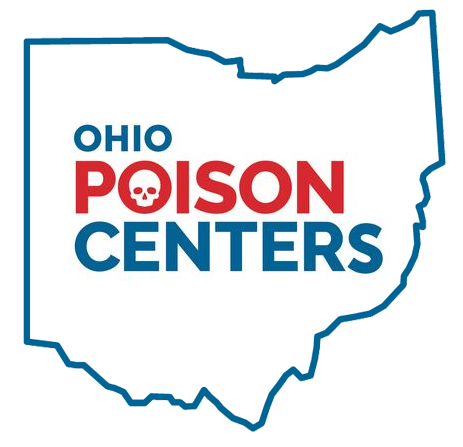Poisonous Plants
There are many native plant species in Ohio that are considered poisonous if exposed to your skin and/or swallowed. It is important to familiarize yourself with plants that are growing in your garden beds as well as the plants you keep indoors. Not all plants are fatal if ingested, however you should know if your indoor and outdoor plants could be toxic.
Here is a list of poisonous plants that are found in Ohio. This list is not all inclusive.

- Azalea
- Buckeye Tree
- Castor Bean
- Diffenbachia
- Foxglove
- Giant Hogweed
- Hemlock
- Henbane
- Jimson Weed
- Moon Flower
- Mountain Laurel
- Mushrooms
- Nightshade
- Oleander
- Poison Ivy
- Poison Sumac
- Rhododendron
- Wild Parsnip
How do I protect myself?
If you are doing yard work or hiking in the woods, you could come in contact with a poisonous plant. To protect your skin, wear long sleeves, pants, boots and gloves when walking in wooded areas or working with thick brush. Be sure to wash your clothes and tools after being outdoors. DO NOT burn poisonous plants or brush piles that COULD contain poisonous plants. If you have poisonous plants in your garden beds or as indoor plants, label the plants and keep them out of reach of pets and children.
There are over 2,000 kinds of mushrooms in Ohio and many of them are poisonous if eaten. Do not eat wild mushrooms growing in your yard or in the woods. Remove the mushrooms growing in your yard and throw them away in a covered trash bin. It is very difficult to tell if a mushroom is poisonous to eat or not.
What if I am exposed?
If you think you touched a poisonous plant, immediately rinse the exposed skin with soap or detergent and lots of water. You also need to scrub under your nails with a brush. Call the poison center for treatment options. If the reaction is severe, seek medical attention.
Treating exposure to poison ivy, poison oak, and poison sumac:
If you are exposed to poison ivy, poison oak, or poison sumac, rinse your skin with lukewarm, soapy water as soon as possible. The sooner you rinse, the more likely you are to remove the oil before it is absorbed into your skin. If not washed off, the oil can spread from person to person, and to other areas of your body.
There are some specialized cleaners sold as ‘poison ivy soaps’ (Tecnu®, among others) that may be more effective in removing the sticky oil from your skin, however common hand or dish washing liquids may be just as effective.
Next, thoroughly wash (separately) all of the clothes you were wearing when you came into contact with the plant, along with any objects (tools, backpacks, golf clubs, etc.) and any pets that may have been exposed as well. The oil can stick to clothing and objects, and can cause another rash if it comes into contact again with your skin.
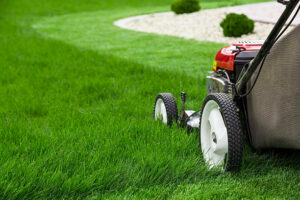
Lawn Care Products
Lawn care products such as pesticides or fertilizers can be toxic to pets as well as people. Always store these products in their original containers in a place where children and pets are not allowed to go. Keep pets and children away from areas that are being treated with these products. Be sure to read labels before using and follow directions carefully.

Outdoor Entertaining
Petroleum based products such as Tiki-Torch fluid and charcoal lighter fluids are extremely toxic and are often used in outdoor entertainment spaces. Store these products in a place where children do not have access. Never keep non-food items in food containers. Adults, as well as children have been poisoned drinking Tiki-Torch fluid mistaken for apple juice.
Swimming pools rely on the safe use of chemicals to prevent the spread of germs in the water. Chemicals used to maintain the water’s pH and disinfectant levels can be toxic if exposed to in concentrated amounts. Be sure to store these chemicals up high and out of sight and reach of children.
Summertime often means cookouts with family and friends. Make sure that food is not out in hot temperatures to prevent spoiling. Meat should be cooked to a safe minimum temperature to prevent food poisoning.
Please visit the USDA for more information on Safe Minimum Internal Temperatures.
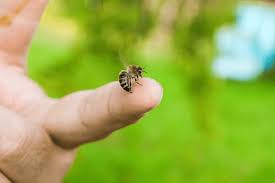
Bites & Stings
What can bite and sting in Ohio?
- Spiders
- Snakes
- Pets
- Bees, wasps, hornets, yellow jackets
- Wild animals
- Caterpillars
- Ticks
- Ants
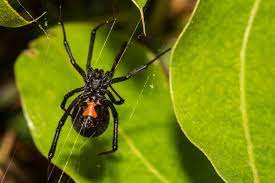
Spiders
Two groups of spiders that are considered dangerous to humans are black widow spiders and recluse spiders.
Recluse spiders are yellowish to grayish brown with faint or distinct violin-shaped marks on their backs. They can be found both indoors and outdoors and prefer dimly lit areas. Recluse bites can cause lesions, nausea, fever and wounds that are slow to heal, which can cause secondary infections.
Black widow female spiders are shiny black with a red hourglass shaped mark on the underside of their abdomen. Male spiders are about half the size of females with red dots on the top of their abdomen. Only females can have bites large enough to pierce skin; males cannot pierce skin. These spiders are considered the most dangerous in Ohio and are often found in woodpiles, under overhangs, or under outdoor furniture. They prefer dryer, darker areas. Black widow bites can cause muscle cramps and spasms that start near the bite and spread outward, seizures, chills, fever, nausea, sweating, and pain in the stomach, back or chest.
If you suspect that you have been bitten by a poisonous spider, call your poison center right away.
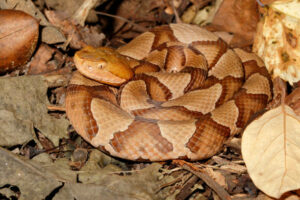
Snakes
There are three species of poisonous snakes found in Ohio, the copperhead, the massasauga, and the timber rattlesnake. The copperhead has hour-glass shaped markings that are brown to orange in color which helps them blend with the forest floor where they generally live. The massasauga can be up to two feet long and often live near the edges of wetland areas. They have a high-pitched buzz-like rattle that almost sounds like a grasshopper. These snakes are usually gray or light brown in color with large light-edges chocolate brown to black splotches on their backs with smaller blotches on their sides. This snake species is threatened and is not very common in Ohio. The timber rattlesnake can reach up to 4 feet in length. They have a pattern of dark colored chevrons/triangles on dark brown to golden-colored backs. Some timbers are almost completely black. You can find these snakes on the forest floor in warmer months.
Steps to prevent snakebites:
1. WEAR THE RIGHT GEAR:
To prevent a snake from biting your feet or legs, wear loose, long pants and high, thick leather or rubber boots when walking through snake-prone areas. If you’re doing yard work or collecting sticks for a fire, wear leather gloves to prevent them from biting your hands.
2. AVOID SCARING A SNAKE:
Snake bites typically happen when someone accidentally steps on them or when they are frightened. To avoid this, it’s best to take extra precaution when they’re more active – at night and in warm weather. Also stay away from areas where they could be hiding, like tall grass, piles of leaves, rocks, and brush. If you need to walk through tall grass or weeds, use a stick to poke at the ground in front of you to scare them away. If you’re out at night, shine a flashlight on the path in front of you.
3. USE THE BUDDY SYSTEM:
If you’re headed out in an area known for venomous snakes, make sure to take someone with you. That way, if you are bitten by a snake or have another emergency, someone else will be there to help you. Remember to charge your phone and stay where you can still get a signal.
4. AVOID TOUCHING OR HANDLING A SNAKE:
It sounds like an obvious tip, but never pick up a snake, even if you think it is dead or nonvenomous. Recently killed snakes are still able to bite by reflex — even detached snake heads!
What to Do If Bitten By A Snake:
DO’S
- DO try to keep stay still and calm.
- DO call the poison center immediately (800) 222-1222. Every snakebite is different. We can determine next steps based on the situation. If you need immediate care, we can tell you where to go and call ahead.
- DO call 911 immediately if the person is having trouble breathing or losing consciousness.
- DO ask someone to drive you to the nearest ER if you are in a remote location and do not have mobile phone service.
- DO keep the part of the body that was bitten straight and at heart-level, unless told otherwise by the specialist at the poison center.
- DO take off all tight clothing and any jewelry.
- DO wash the bite with soap and water and cover it with a clean, dry dressing (if available), so long as it does not cause a delay in getting treatment.
- DO try to remember the color and shape of the snake, but don’t move closer to it. This can help us determine the best treatment. Only take a photo if you can do so from a safe distance.
- DO note what time the bite happened.
DON’TS
- DON’T attempt to pick up, kill, or trap the snake.
- DON’T apply a tourniquet or attempt to restrict blood flow to the affected area.
- DON’T cut the wound.
- DON’T attempt to suck out the venom.
- DON’T apply heat, cold, electricity, or any substances to the wound.
- DON’T take any medications.
If you have been exposed to an outdoor hazard or have any questions, call your Poison Center at 1-800-222-1222.
